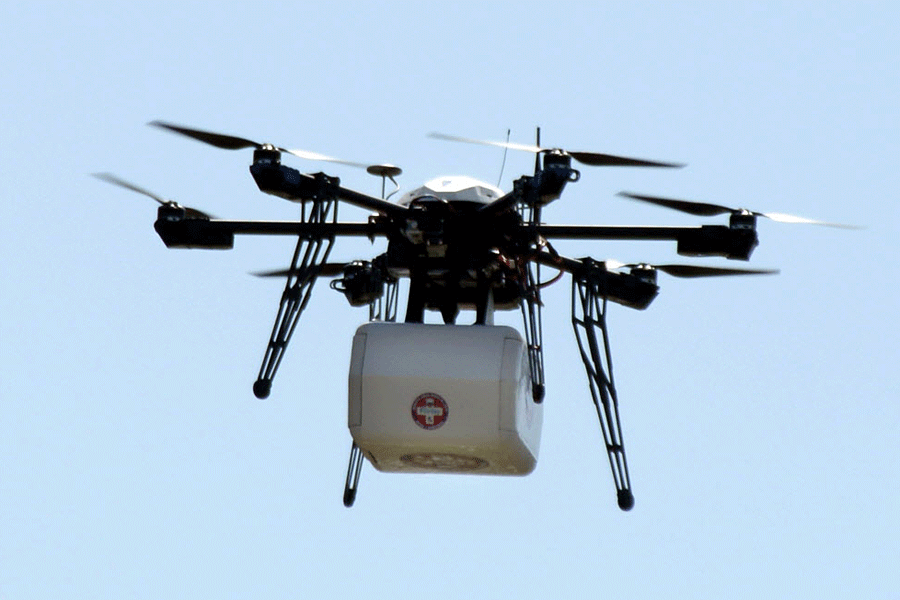Drone (legally) delivers packages, but the technology still needs work
Loading...
On Friday, the unmanned delivery startup, Flirtey, launched a drone that successfully delivered a package of medical supplies to a remote medical facility in Wise County, Va. The company, which is looking to pave the way for consumer delivery by drone, is hailing this flight as the “Kitty Hawk” of unmanned aerial parcel post.
A bit of hyperbole, perhaps. While the Federal Aviation Administration (FAA) may be moving ahead with drone approval, there remain technical obstacles to residential unmanned air deliveries, note observers.
This test flight, which was launched in coordination with the Mid-Atlantic Aviation Partnership at Virginia Tech, was granted research permissions by the FAA to test Unmanned Aircraft System (UAS) flights. This test flight comes several months after the FAA approved testing access to Seattle-based Amazon for their “Prime Air” delivery service.
Getting authorization from the FAA is not easy. “Important safety and logistical matters needed to be considered by the Federal Aviation Administration,” Rose Mooney, executive director of the Mid-Atlantic Aviation Partnership at Virginia Tech, told the Roanoke Star. “We needed to demonstrate that we had done our homework to ensure optimum safety.”
The FAA’s regulations, which have recently allowed civilians to apply for flight permissions, are intended to curb dangerous or potentially unsafe drone flights. The test flight, which autonomously delivered a package of prescriptions to a remote medical facility in Wise County, consisted of two smaller flights – one larger drone delivering supplies to a smaller drone which would take the trip to facility. At this point, battery life is not advanced enough to allow a single vehicle to travel the 20 miles from Oakwood to Wise County, according to PC Mag.
Flirtey, which worked with the “Let’s Fly Wisely” campaign to launch this test flight, says that this "is an important step toward a future where unmanned aircraft make routine autonomous deliveries of your everyday purchases,” CEO Matt Sweeny told the Roanoke Star.
But not everyone is as optimistic about the flight as the CEO of the company which launched it. Some see major barriers to consumer delivery drones in safety regulations, technological capability, and cost.
IEEE Spectrum’s Evan Ackerman says that this flight didn’t change much in the way for consumer drones. In fact, he sees the problems of delivery drones exactly where they were over a year ago.
“It’s great that they made it work, but it’s not a demonstration of any specific technology that will bring delivery drones any closer to realistic usefulness,” says Mr. Ackerman. “It’s simply a drone navigating autonomously from GPS waypoint to GPS waypoint.”
In order to structure the test flight, the FAA ensured that no other vehicles would be in the air, and that the surrounding area would be clear in case of emergency. The vehicle also delivered a package from a relatively open area to a relatively open area; if consumer delivery drones are to become commonplace, these machines are going to need to operate in a more relevant environment like city blocks and suburbia, where obstacles like trees and people may pose problems.
As Geekwire reported, when asked about Amazon's drone delivery plans, 3D Robotics CEO Chris Anderson expressed skepticism:
While the idea of autonomous copters flying around seems convenient for delivery, there are significant safety risks when flying drones over residential areas. He’s concerned about a drone potentially crashing into people, homes or other objects while in the process of making a delivery. With multiple whirling blades, a malfunctioning Amazon drone could cause a lot of damage to people or property.
For a delivery drone to meet consumer demands, it must be cheaper, safer, and more efficient than, say, conventional delivery methods.
For that, Ackerman acknowledges that there are situations where drone deliveries do make sense: when reaching remote facilities or in cases where human travel is difficult or impossible. Relief situations and medical emergencies, similar to the test scenario on Friday, may be the most applicable uses for drone delivery.
Currently, the technology hasn’t gotten to a point where an autonomous vehicle can properly observe and traverse the obstacles in way of a street address. To reach a destination, the UAS needs exact GPS coordinates. One Sydney company is experimenting with textbook delivery via drones.
CNET reports on how they hope it will work:
They will have to order delivery to an outdoor area, and the drone will find the customer based on GPS coordinates sent from an Android app (an iOS app will be built after the program is launched). The UAV will hover over the location and lower the textbooks on a retractable cable, allowing the customer to detach the parcel and the drone to be on its way. The entire process could take as little as two or three minutes.
If the customer isn't there, the textbooks won't be lowered; the customer will have to hit a button on the app to lower the parcel. The drone will wait a short time for the command before flying away, and delivery will have to be rescheduled.
There remain hurdles, but more companies are trying to push the envelope on drone delivery.






